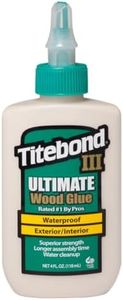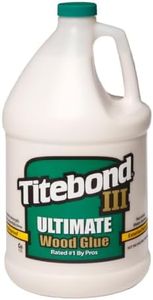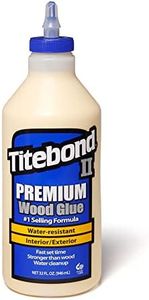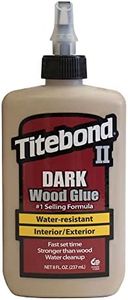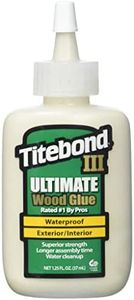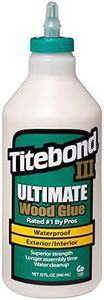We Use CookiesWe use cookies to enhance the security, performance,
functionality and for analytical and promotional activities. By continuing to browse this site you
are agreeing to our privacy policy
10 Best Exterior Wood Glues
From leading brands and best sellers available on the web.Buying Guide for the Best Exterior Wood Glues
Choosing the right exterior wood glue is crucial for any outdoor woodworking or repair project. Unlike regular glue, exterior wood glues need to stand up to moisture, changing temperatures, and the wear and tear of being outside. Picking the right glue involves understanding a few key features so that your bond stays strong and durable, no matter the conditions. Think about how and where you’ll use the wood glue – whether you’re building garden furniture, repairing a fence, or constructing a deck – as this will help guide your selection.Water ResistanceWater resistance refers to how well the glue can handle exposure to water and humidity. This is important because outdoor projects often get wet due to rain, dew, or just the environment. Water resistance is usually rated by standards like ANSI Type I, II, or III. Type I means it's fully waterproof and can handle long soaking, Type II can handle some moisture and brief exposure, while Type III is more for indoor use. If your project will face heavy rain or constant exposure, aim for Type I; for occasional dampness like garden furniture under a porch, Type II might be enough. Match the level of water resistance to how wet or exposed your project will be.
Bond StrengthBond strength is how well the glue holds wood together, especially under stress or weight. For outdoor furniture or structures that bear a load or get knocked around, you'll want a glue with high bond strength to avoid breaks or joints coming loose. Some glues are designed for light-duty repairs, while others are rated for heavy structural work. Consider what the glue will be holding: for delicate projects, moderate bond strength is sufficient, but bigger builds need maximum strength.
Drying Time and Working TimeDrying time is how quickly the glue sets, while working time is how long you have to adjust your pieces after applying the glue. Fast-drying glues are good if you want to finish quickly, but they give you less time to reposition parts. Slower-drying glues provide flexibility for assembly but require patience before the bond is strong. Choose a drying and working time that matches your skill level and project pace – for detailed or complex assemblies, longer working time is a plus; for quick repairs, faster drying might be better.
Application TypeApplication type covers how easy it is to use the glue and what tools you might need. Some glues come ready to use in squeeze bottles, while others need mixing or spreading with a brush. If you’re new to woodworking or just want convenience, look for glues in easy-squeeze bottles. For larger projects involving a lot of joints, you may need a glue that spreads easily and works well in gaps.
Clean-up MethodClean-up method is about how you remove excess glue or clean your tools afterward. Some exterior wood glues can be cleaned with water when wet, which is easier and safer, while others require special solvents. If you prefer a simpler, quicker clean-up, choose a glue labelled as water-cleanup. For those who don't mind a little extra effort or are working on a job that demands higher performance, solvent-cleanup glues can be considered.


